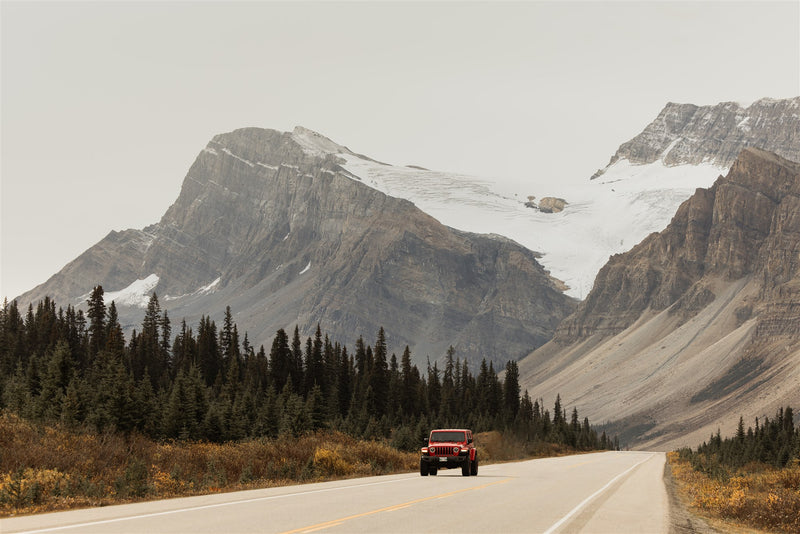Equipping Your Off-Road Vehicle for Winter Adventures
When winter comes, adventurers swap trails for snowy peaks, trading dirt for snow and warm sunsets for crisp, icy mornings. Off-road winter adventures offer unparalleled beauty and unique challenges, but they require careful planning and preparation to ensure safety and enjoyment. This guide will help you prepare your vehicle and yourself for the ultimate winter off-road experience.
Winter landscapes can be breathtaking, with pristine snow-covered forests, frozen lakes, and rugged mountain ranges. However, these picturesque environments also present significant risks, including extreme cold, rapidly changing weather, limited daylight, and treacherous terrain. Successfully navigating these challenges demands a combination of knowledge, preparation, and the right equipment. This comprehensive guide is designed to help you plan your journey, equip your vehicle, and enjoy the adventure safely.
1. Pre-Trip Vehicle Inspection
Before embarking on any off-road winter adventure, a thorough inspection of your vehicle is non-negotiable. Cold weather can exacerbate existing issues, turning minor problems into major headaches. Here’s a detailed checklist for ensuring your vehicle is winter-ready:
-
Check the Battery: Ensure your battery is fully charged and in good condition. Perform a load test to be sure it's in good health. Cold weather reduces battery efficiency, so a weak battery might not start your engine in sub-zero temperatures. Consider carrying a portable jump starter or battery booster as a backup.
-
Inspect Tires: Verify that your tires are winter-rated and have sufficient tread depth. Winter tires are designed with softer rubber compounds and deeper treads to improve grip on icy surfaces. Consider carrying tire chains for added traction in deep snow or on icy roads.
-
Examine Fluids: Make sure the vehicle is on level ground and check the fluid levels.
-
Windshield Washer Fluid: Use a winter formula that won’t freeze, and bring an extra jug.
-
Coolant / Antifreeze: Ensure the correct mix for freezing temperatures to prevent engine damage.
-
Oil, Transmission, Power Steering, Brake Fluids: Check and top up levels as required.
-
-
Test Lights: Check headlights, fog lights, and taillights for full functionality. Clear off any snow or ice before driving, as visibility is crucial during winter.
-
Inspect Belts and Hoses: Look for cracks or wear that could lead to failures in extreme cold. Cold temperatures can make rubber components brittle.
-
Winch Maintenance: If your vehicle has a winch, test it to ensure it’s functioning properly. Lubricate moving parts and inspect the cable or synthetic line for wear.
-
Check Wipers: Replace worn windshield wipers with winter-rated ones to handle snow and ice buildup.
2. Essential Gear for Winter Off-Roading
Preparation is the key to surviving and thriving in winter conditions. The following gear is essential for any off-road winter adventure:
Recovery and Traction Equipment
Winter terrain often includes snow, ice, and mud, making traction and recovery gear crucial:
-
Heavy-duty recovery boards (e.g., MaxTrax or similar) for self-recovery in snow or mud.
-
Tire chains to improve grip on icy or snow-packed surfaces.
-
A high-capacity winch with a synthetic line for pulling your vehicle out of difficult situations.
-
Snatch straps, tree savers, and D-ring shackles for versatile recovery setups.
-
Shovel for digging out of snowbanks or creating traction paths.
-
A traction aid like sand or a traction boards to help regain grip.
Emergency Communication Systems
Reliable communication is essential for safety and coordination:
-
GMRS Radio: Ideal for short-range group communication.
-
uVHF Radio: Provides additional range and versatility for remote areas.
-
weBoost Cell Signal Booster: Enhances cell coverage in areas with weak signals.
-
Starlink Satellite Internet: Offers reliable internet for navigation and emergency communication in remote locations.
- Garmin inReach: Provides basic satellite communication and the ability to quickly send a distress signal.
Navigation and Planning Tools
Always know your route and plan for contingencies:
-
Paper maps and a compass as backups to electronic devices.
-
GPS devices or apps like OnX Offroad for real-time mapping and route tracking.
-
Preload routes and mark critical waypoints to stay on track even without connectivity.
3. Personal Safety and Survival Gear
The safety of you and your passengers is paramount. Winter conditions can be harsh, so ensure you’re equipped for any eventuality:
Clothing and Warmth
Dressing appropriately is vital for staying warm and dry:
-
Base layers made of moisture-wicking materials like merino wool or synthetic fabrics.
-
Insulated jackets and pants to retain body heat.
-
Waterproof outer layers to block wind and moisture.
-
Thermal gloves, hats, and socks to protect extremities from frostbite.
-
Spare clothing, including socks and gloves, in case of wet conditions.
Lighting
Lighting is critical during short winter days and long nights:
-
High-quality flashlights and headlamps with lithium batteries (e.g., Energizer Ultimate), as they perform well in cold temperatures.
-
Off road lights on your vehicle for navigating dark trails.
-
Extra batteries for all devices to ensure you’re never left in the dark.
First Aid and Emergency Supplies
Prepare for injuries and emergencies:
-
A comprehensive first-aid kit with items like bandages, antiseptic wipes, and pain relievers.
-
Emergency blankets and hand warmers to combat hypothermia.
-
Fire-starting tools like waterproof matches or a fire starter to create warmth in an emergency.
-
A multi-tool or knife for cutting, repairs, or other tasks.
-
High-visibility vests and reflective markers to improve visibility in low-light conditions.
Food and Hydration
Stay nourished and hydrated to maintain energy levels:
-
High-calorie camping meals designed for cold weather, such as freeze-dried meals or MREs.
-
Instant soups, oatmeal, or pasta for quick and warming meals.
-
Hot beverages like coffee, tea, or hot chocolate to stay warm and hydrated.
-
A portable stove or insulated thermos for heating food and drinks.
-
Adequate water supply in insulated containers to prevent freezing.
4. Preparing Your Vehicle for Extreme Cold
Extreme cold can challenge even the most robust vehicles. Take additional precautions to prepare your vehicle:
-
Install Winter Tires: Choose tires specifically designed for winter conditions, with a soft rubber compound and deep treads.
-
Add Auxiliary Lights: Equip your vehicle with additional lighting for navigating in low-visibility conditions.
-
Carry Extra Fluids: Bring extra oil, coolant, brake fluid, and washer fluid for refills as needed.
-
Fuel Management: Keep your tank at least half full to prevent condensation in the fuel lines. Consider adding a fuel supplement for extreme winter conditions.
-
Check Battery Terminals: Clean the terminals to maintain battery efficiency in extreme cold.
-
Check Doors and Seals: Lubricate door seals and locks to prevent freezing.
5. Planning Your Adventure
Check the Weather
Always check the weather forecast for your route and destination. Avoid venturing out in severe storms or avalanche-prone areas. Be prepared for sudden changes in weather, which are common in mountainous regions.
Travel with a Group
Never go alone on winter adventures. Traveling with a group increases safety and provides assistance in case of emergencies. Establish clear communication protocols before setting out.
Know When to Turn Back
Set realistic goals and recognize when conditions are too risky. It’s better to cut a trip short than to face dangerous situations. Listen to your instincts and prioritize safety over reaching your destination.
Create an Emergency Plan
Have a detailed plan that includes:
-
Sharing your itinerary with a trusted friend or family member.
-
Establishing check-in points and times to confirm your safety.
-
Preparing for overnight stays if conditions worsen, including setting up an emergency shelter.
- Plan your route with multiple detour and escape options, should conditions degrade or change.
Winter Off-Road Adventure Gear Checklist
Vehicle Gear
-
Battery charger or jump starter
-
Winter tires
-
Tire chains
-
High-capacity winch
-
Snatch straps, tree savers, and D-ring shackles
-
Recovery boards
-
Shovel
-
Auxiliary lighting
-
Extra fluids (oil, coolant, brake fluid, transmission fluid, power steering, washer fluid)
Communication and Navigation
-
GMRS radio
-
uVHF radio
-
weBoost cell booster
-
Starlink satellite internet
-
GPS device and backup maps
-
Compass
Safety and Survival Gear
-
Flashlights and headlamps with lithium batteries
-
First-aid kit
-
Emergency blankets and hand warmers
-
Fire-starting tools
-
Multi-tool or knife
-
High-visibility marker panels. The military uses high-visibility panels called VS-17 panels, which are also available for purchase.
Clothing
-
Base layers
-
Insulated outerwear
-
Waterproof gloves and boots
-
Thermal hats and socks
-
Spare clothing
Food and Hydration
-
High-calorie camping meals
-
Instant soups and beverages
-
Portable stove
-
Insulated thermos
-
Adequate water supply
Miscellaneous
-
Paper maps
-
Portable power bank
-
Snow brush and ice scraper
-
Tool kit for emergency repairs
-
Spare parts (belts, hoses, etc.)
Proper preparation ensures your winter off-road adventure is both safe and memorable. With the right gear, planning, and mindset, you can explore snow-covered landscapes with confidence and create experiences that last a lifetime. Stay safe, stay warm, and enjoy the limitless adventure!


